This post contains affiliate links, which means I may earn a commission if you purchase through those links (at no extra cost to you).
I grew up making Orange Marmalade the old-fashioned way: soaking citrus overnight and boiling it rigorously to extract the natural pectin in the rind. When you follow my technique, you don’t need to add any store-bought pectin, and you get the best, cleanest-tasting marmalade.
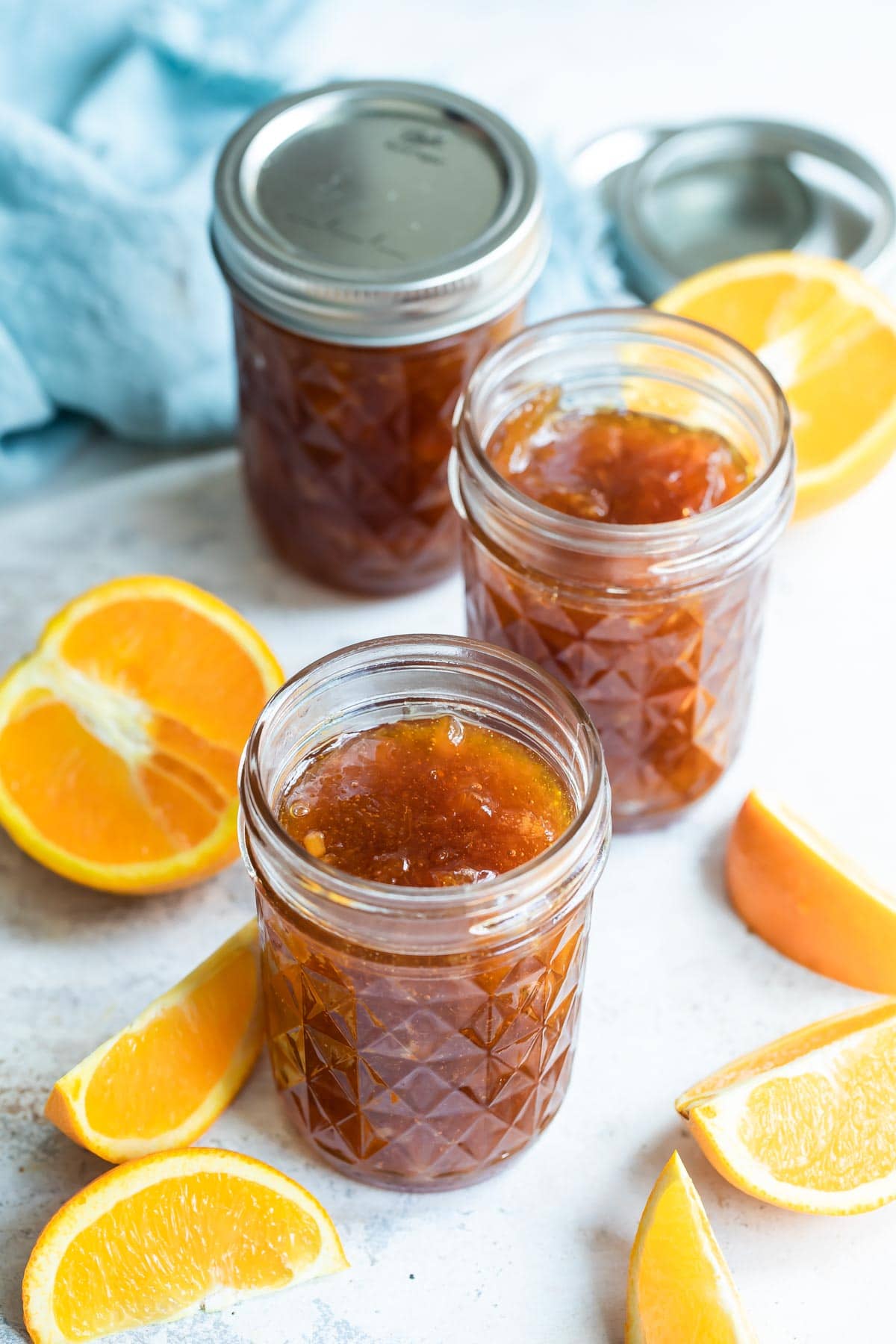
Nearly 1,000 5-star reviews prove this unfussy technique is simple and easy to follow. I also include my handy “cold plate test” so you can know for sure whether your marmalade is done or needs a little bit more time on the stove.
Home cooks everywhere are putting their abundant citrus to use to make their own homemade marmalade, and now you can, too. This recipe makes about 3 quarts total, or 12 (8 ounce jars). It freezes beautifully or you can process it in a water bath for canning.
Table of Contents
Marmalade Ingredients
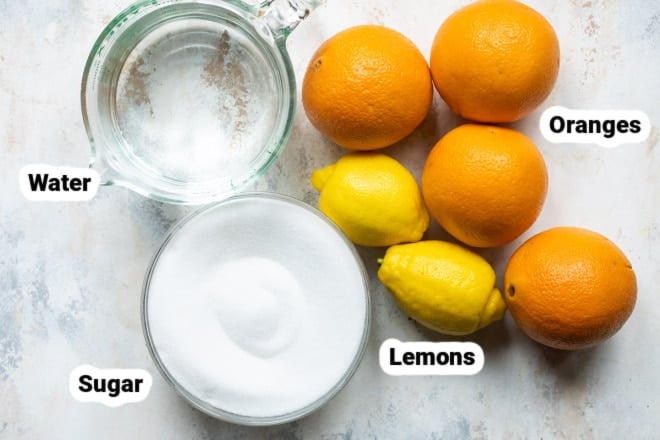
At a Glance: Here is a quick snapshot of what ingredients are in this recipe.
Please see the recipe card below for specific quantities.
- Oranges: This recipe is made with regular seedless oranges. You can definitely substitute Seville oranges if you can find them. They are only in season from the end of January to mid-February, but they have an intense flavor that is ideal for marmalade.
How to make Orange Marmalade
- Using a sharp knife, cut oranges and lemons in half crosswise, then into very thin half-moon slices. Discard any seeds. In a large pot (stainless steel), add the sliced oranges, lemons, and any fruit juice.
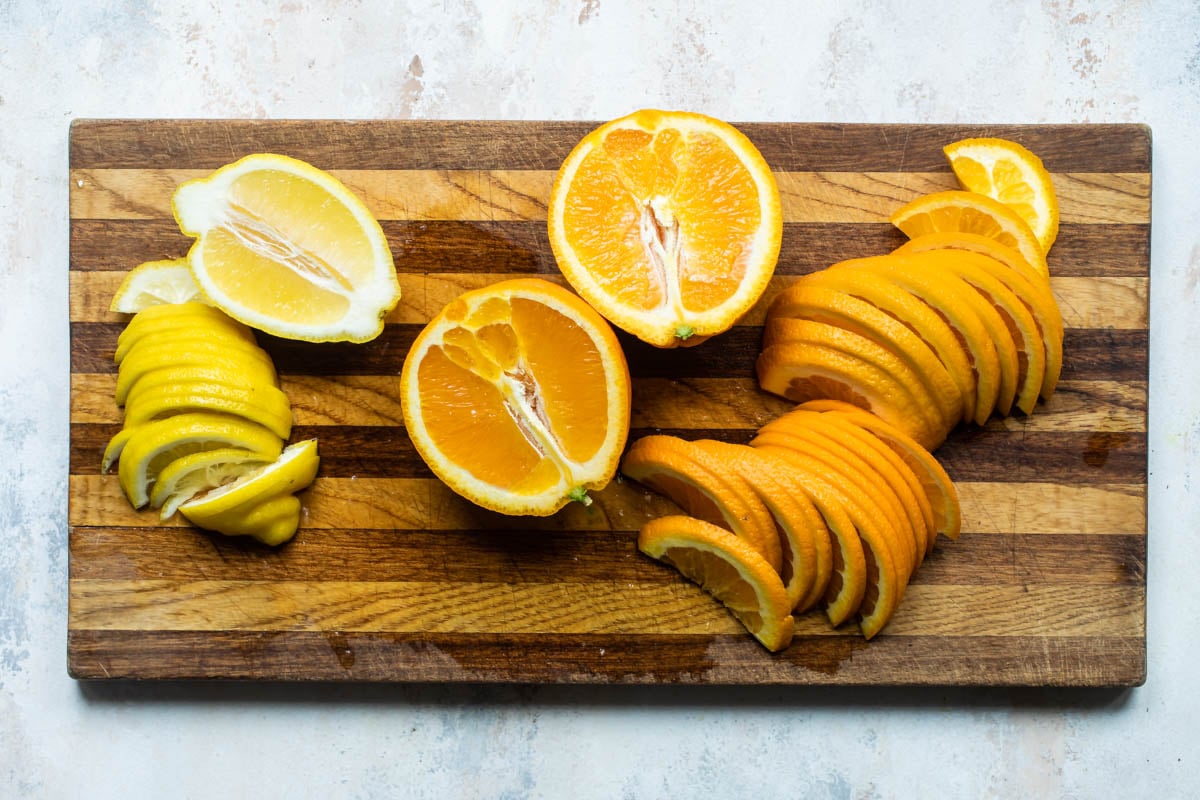
- Add water and bring the mixture to a boil over medium heat, stirring often. Remove from the heat and stir in the sugar until it dissolves. Cover and let stand overnight at room temperature.
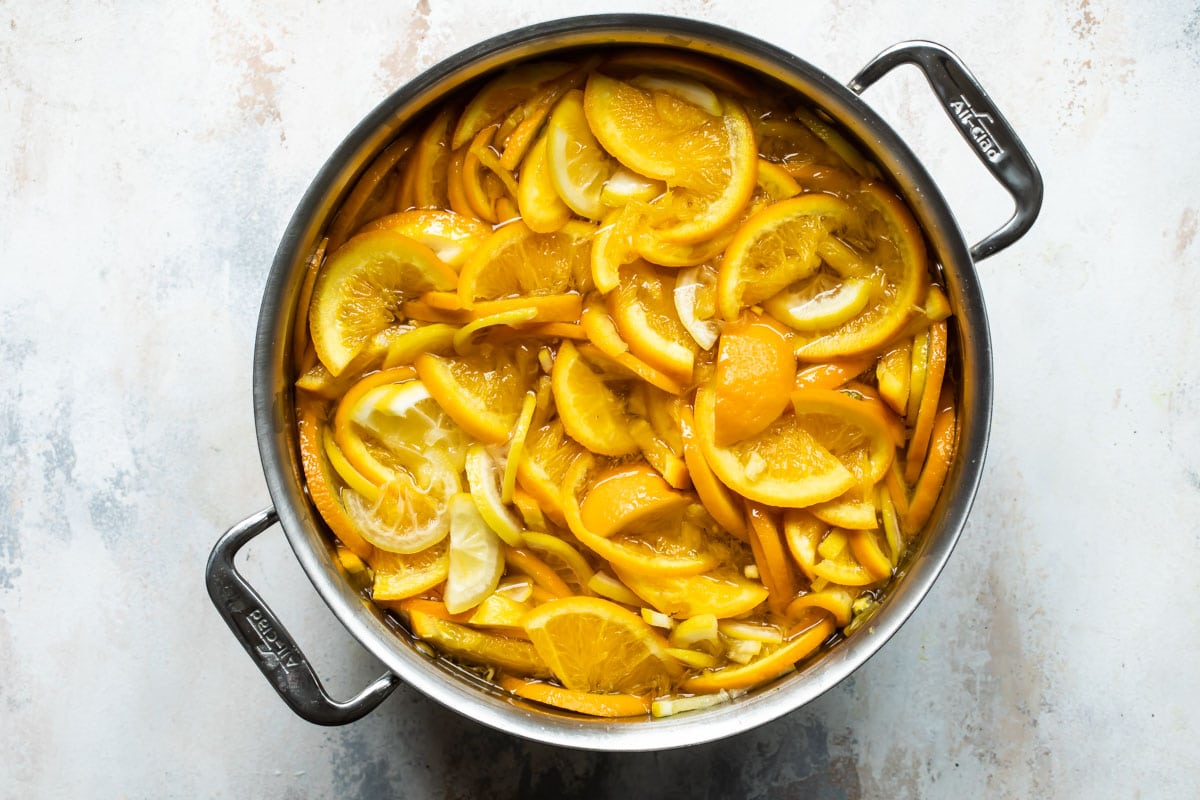
- The next day, bring the mixture back to a boil in the pot or saucepan. Reduce heat to low and simmer uncovered for 2 hours. Turn heat up to medium and boil gently, stirring often, for another 30 minutes. Skim off any foam that forms on the top. Cook until it reaches 220 degrees on a candy thermometer (you must hit this temperature for the natural pectin to gel with the sugar).
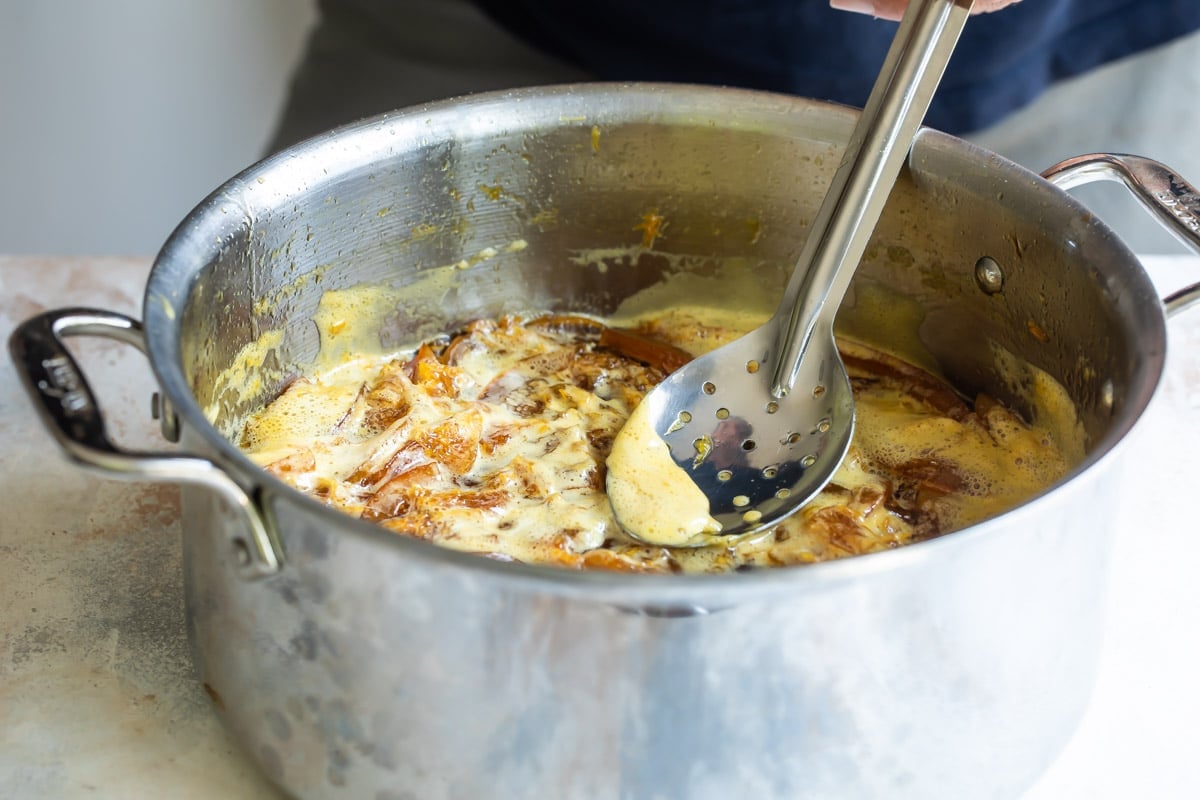
- To test if the marmalade is ready, place a small amount on a plate and refrigerate it until it’s cool but not cold. If it’s firm (neither runny nor hard), it’s ready. It will be a golden orange color. If it’s still runny, continue cooking it; if it’s hard, add a bit more water.
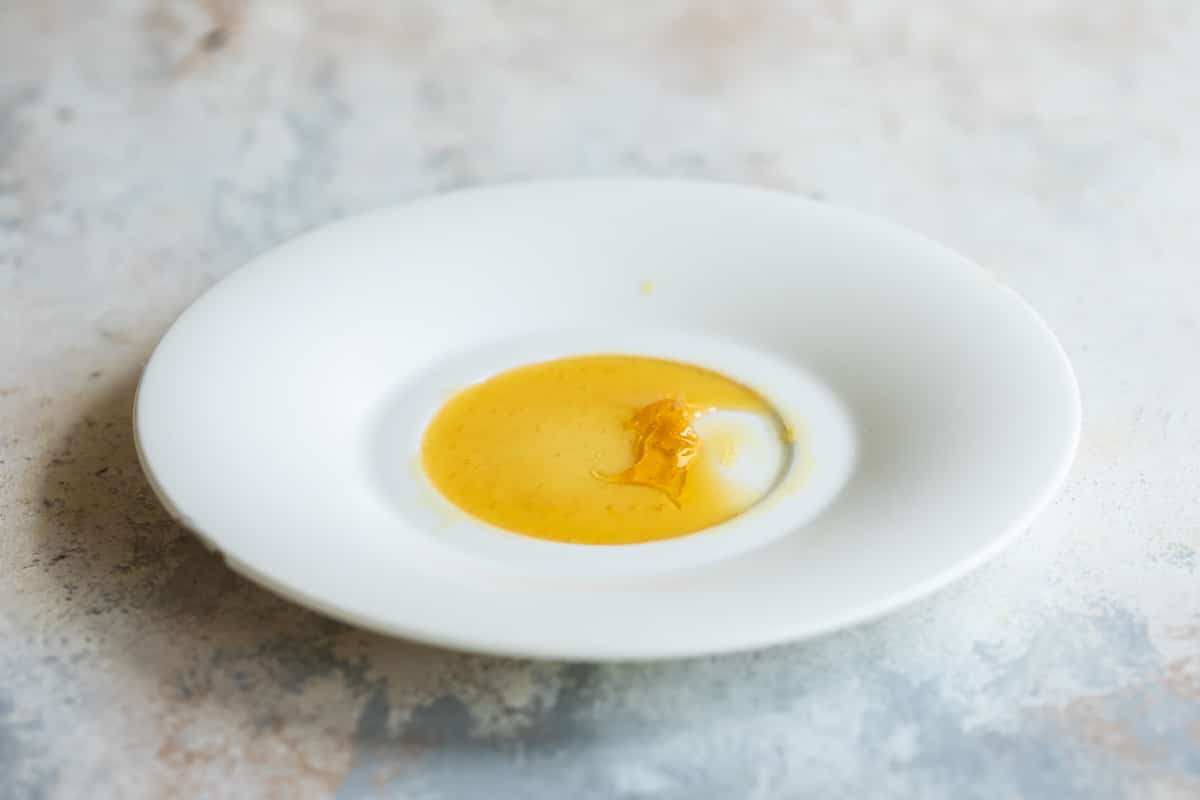
- Pour or ladle the marmalade into clean hot mason jars (I use this wide-mouth jar funnel for this recipe and so many others). Wipe the rims thoroughly with a clean damp paper towel, and seal with the lids. Chill in the refrigerator. It may take 24-48 hours for the natural pectin to set up properly.
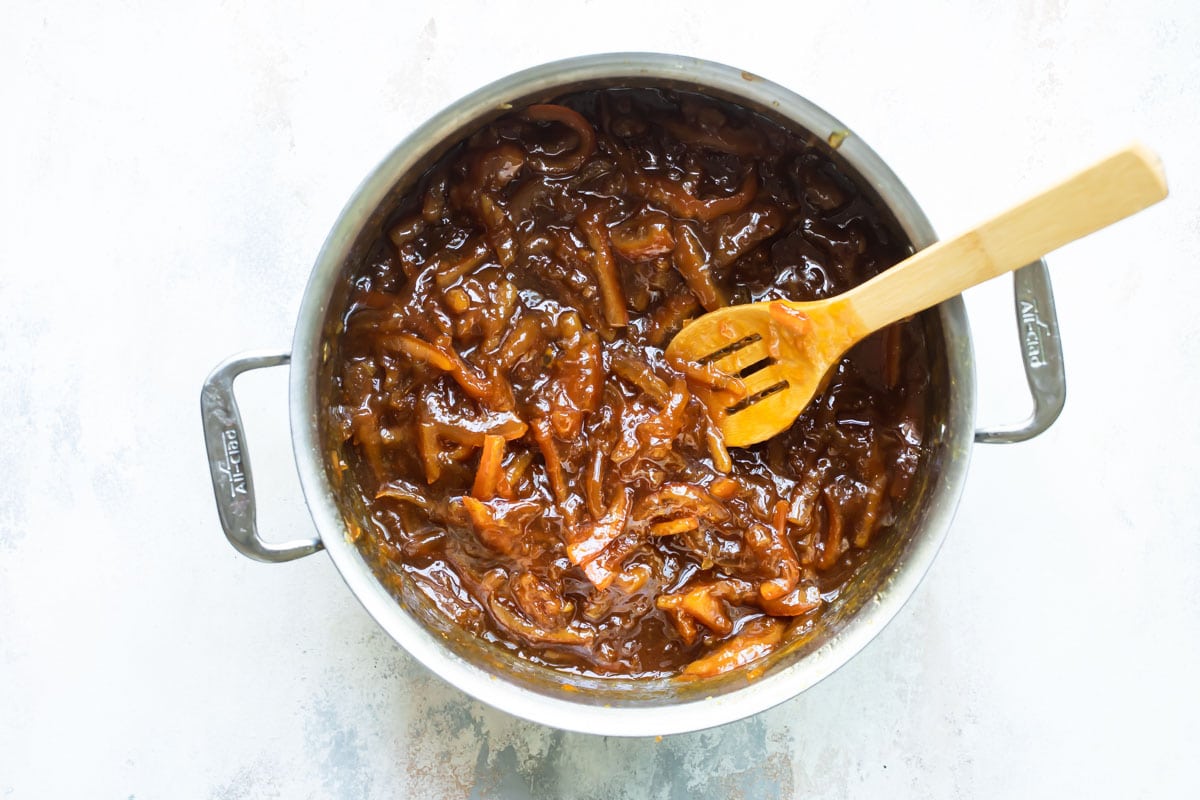
Orange Marmalade Recipe Variations
- Pectin: While many jam and jelly recipes require added pectin, you don’t need to add any here. Pectin is naturally concentrated in the pith of the orange (the bitter white part under the peel). This recipe coaxes out that natural pectin by letting the citrus soak overnight and then boiling it rapidly until enough water has evaporated that the mixture can reach 220 degrees.
- Agave nectar: Agave cannot penetrate and sweeten the peel as well as sugar can. When I tested it, the consistency was fine, but the rind tasted like raw rind. I don’t recommend this substitution.
- Low sugar: I haven’t tested low-sugar/alternative sweeteners in this recipe other than agave as listed above nor have I tweaked the amount of sugar in the recipe. I recommend seeking out recipes from experts in that area.
- Slow cooker: While it is technically possible to make marmalade in your slow cooker, it really depends on the power of your appliance. I no longer recommend that method because it isn’t reliable enough.
- Instant pot: Even with an overnight soak, the IP doesn’t break down the rind sufficiently. I don’t recommend this method.
Marmalade Recipe Tips
- Yield: This recipe makes about 3 quarts (96 ounces) of marmalade.
- If using 1/2-pint (8 ounce) jars, you’ll need 12.
- If using 1 pint (16 ounce) jars, you’ll need 6.
- If using the tiny jelly jars (4 ounce), you’ll need 24.
- Cold-plate test: To test if your marmalade is ready, spoon some hot marmalade on to a small plate and put it in the freezer to chill, or spoon some over an icy cold plate fresh from the freezer. If the mixture wrinkles slightly when you draw a spoon or finger across it, it has reached the setting point and is ready to go! If not, keep boiling and make sure the temperature reaches 220 degrees.
- Set-up time: Orange marmalade takes 24-48 hours for the natural pectin to set up completely. If it’s is still a little runny looking when it cools, check again in a day or two.
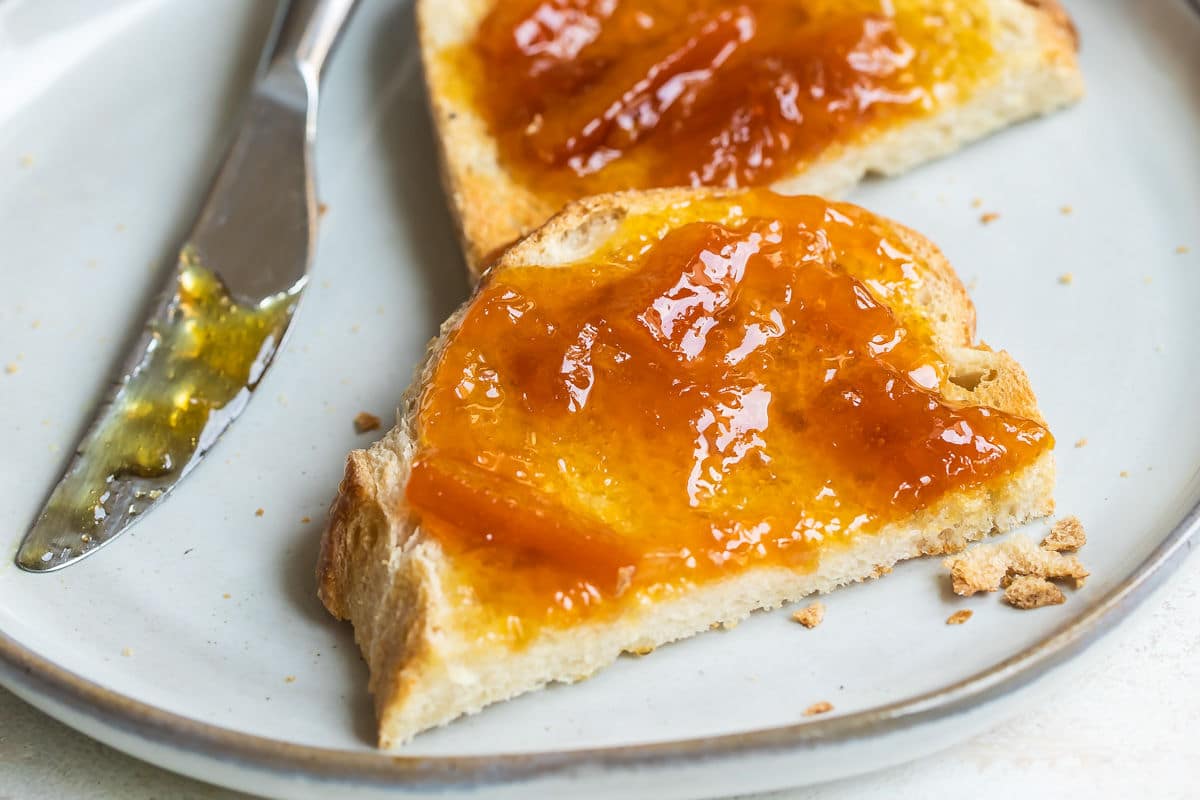
Storing and Canning Orange Marmalade
Storage: Store covered in the refrigerator for up to 1 month.
Freezer: Pack in freezer-safe containers or jars leaving 1/2-inch of headspace for expansion. Label, date, and freeze for up to 3 months. Thaw overnight in the refrigerator.
Canning: If putting up for storage, use a hot water or steam canner with a rack to properly seal lids on canning jars according to canning instructions. Otherwise, refrigerate and use within the month. Or, freeze for up to 3 months.
Frequently Asked Questions
Pectin is naturally concentrated in the pith of the orange (the bitter white part under the peel), so you don’t need to add any here. This recipe coaxes out that natural pectin by letting the citrus soak overnight and then boiling it rapidly until enough water has evaporated that the mixture can reach 220 degrees.
While it is technically possible to make marmalade in your slow cooker, it really depends on the power of your appliance. I no longer recommend that method because it isn’t reliable enough.
Even with an overnight soak, the IP doesn’t break down the rind sufficiently. I don’t recommend this method.
Agave cannot penetrate and sweeten the peel as well as sugar can. When I tested it, the consistency was fine, but the rind tasted like raw rind. I don’t recommend this substitution.
I don’t recommend making this recipe in a regular cast iron pan. It should be made in a non-reactive pan. Enameled cast iron, stainless steel, and non-stick are best and will not affect the color or taste of the marmalade
More fruit recipes
Pie and Tart Recipes
Fresh Fruit Tart
Fruit Dessert Recipes
Apple Crisp with Oatmeal
Cake Recipes
Lemon Bundt Cake Recipe
Muffins and Quick Breads
Banana Muffins
Join Us

Orange Marmalade
Equipment
- Jar funnel (for wide mouth jars)
Ingredients
- 4 large seedless oranges scrubbed clean (about 3 pounds or 8 cups slices, see note 1)
- 2 lemons (about ½ pound or 1 cup slices)
- 8 cups water
- 8 cups granulated sugar
Instructions
- Cut oranges and lemons in half crosswise, then into very thin half-moon slices. Discard any seeds. In a large stainless steel pot, add the sliced oranges, lemons, and any accumulated juices.
- Add water and bring the mixture to a boil, stirring often. Remove from the heat and stir in the sugar until it dissolves. Cover and let stand overnight at room temperature.
- The next day, bring the mixture back to a boil. Reduce heat to low and simmer uncovered for 2 hours. Turn heat up to medium and boil gently, stirring often, for another 30 minutes.
- Skim off any foam that forms on the top. Cook the marmalade until it reaches 220 degrees (you must hit this temperature for the natural pectin to gel with the sugar).
- To test if the marmalade is ready, place a small amount on a plate and refrigerate it until it's cool but not cold (see note 4). If it's firm (neither runny nor hard), it's ready. It will be a golden orange color. If the marmalade is runny, continue cooking it; if it's hard, add a bit more water.
- Pour the marmalade into clean hot mason jars; wipe the rims thoroughly with a clean damp paper towel, and seal with the lids. Chill in the refrigerator. It may take 24-48 hours for the natural pectin to set up properly.
Recipe Video
Notes
- Oranges: This recipe is made with regular seedless oranges. You can definitely substitute Seville oranges if you can find them. They are only in season from the end of January to mid-February, but they have an intense flavor that is ideal for marmalade.
- Yield: This recipe makes about 3 quarts (96 ounces) of marmalade.
- If using 1/2-pint (8 ounce) jars, you’ll need 12.
- If using 1 pint (16 ounce) jars, you’ll need 6.
- If using the tiny jelly jars (4 ounce), you’ll need 24.
- Storage: Store covered in the refrigerator for up to 1 month.
- Cold-plate test: To test if your marmalade is ready, spoon some hot marmalade on to a plate and put it in the freezer to chill, or spoon some over an icy cold plate fresh from the freezer. If the mixture wrinkles slightly when you draw a spoon or finger across it, it has reached the setting point and is ready to go! If not, keep boiling and make sure the temperature reaches 220 degrees.


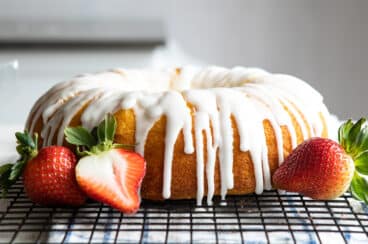
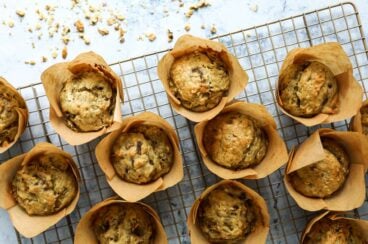
In future would it be ok to use limes instead of lemons?
Hi again, Jenny! Lime works just as well instead of lemons, the peel might be a little more noticeable but that’s it. My friends in Mexico have made this with limes because they rarely have lemons there. Thank you again and please write with anymore questions! – Meggan
This recipe is without a doubt the best tasting marmalade I have ever made. Thank you so much for this fabulous recipe.
You’re welcome, Jenny! So glad you loved it! – Meggan
We made this with some super sweet navel oranges we have growing in the back yard. I added a teaspoon of cinnamon and a splash of whiskey and it came out amazing! Our yield ended up being 4 + 1 (3/4) 16Oz mason jars (~76Oz)
That sounds amazing, Quinn! – Meggan
This marmalade turned out perfectly. I like jam a little less sweet so I used 6 cups of sugar. I also used immersion blender to break up some peel and did so during end of simmer. It set perfectly and was really good. Ty for the recipe. The he instructions were perfect.
You’re welcome, Marci! I’m so glad you loved it! – Meggan
How long do you water bath?
Hi Abigail, you’ll want to water bath process them for 10 minutes for pints, adjusting for altitude if needed. I hope you love it! – Meggan
I made this with Cara Cara Oranges and Blood Oranges, no lemons, 6 cups of sugar and 6 cups of water. AMAZING! No need to search for Seville Oranges.
I did have some difficulty getting the mixture to reach 220o. But it stayed at 118o and that was fine. In my effort to get it up to 220, I did burn the bottom. So if you turn the heat up high, keep stirring!
Thank you for writing, Elaine! I’m sorry it burned, but it sounds like you were able to save the batch! I hope your next one is perfect. Take care! – Meggan
Hi there 😊,
Would it negatively affect the result if the oranges are soaked for 12 hours instead of 8?
Hi Marci! It’s absolutely fine to soak longer than 8 hours. Soaking is to soften the fruit and the peels and I’ve definitely soaked them longer than 8 hours. I don’t know if there is a maximum time, but the longer it soaks the softer the peels should be. I hope you love this marmalade! – Meggan
Hello! I made this recipe, I did skip the soaking part. I only soaked for two hours. However, I have an almost burnt aroma coming from my finished product. Where did I go wrong? Did I simmer it at too high of a level for the two hours possibly? I would appreciate any insight you may have.
Hi Tessa, I’m sorry your marmalade didn’t turn out. The soak is an important part of this recipe, it coaxes the natural pectin out of the oranges and softens the rind, so I don’t recommend skipping that step. I would agree that the burning smell may be due to the heat being too high during the simmer or the gentle boil. Sorry again and I hope your next batch is better. – Meggan
Awesome jam every time. I have made three batches from my own orange tree mandarins and the jam from them was out of the world. I used only 5&1/2 cups of sugar instead of 8 cups as my mandarins are so sweet and the recipe still turned out great!
Thank you for the recipe!
You’re welcome, Sonal! Sounds delicious! – Meggan
This is the second year that I’ve used this recipe, which was very popular with my family the first time I used it. This time, I cooked and water-bath canned 12 half pints and 2 pints of orange marmalade, using 12 Satsuma Oranges, 3 Lemons, and 8 cups of Sugar, 8 Cups of Water. I’m not able to get the cooked temperature to 220F, only to 218F, so I’m hoping refrigerating the marmalade filled jars will help solidify it a bit. Is there something I could do to compensate for the problem I have which is that my propane gas stove will not heat the mixture above 218F?
Hi Betsy, thank you so much for writing! I think you may be able to overcome the temperature difference by simmering longer in step 3 and 4, and relying on the cold-plate test in step 5 to determine when it’s ready. I believe you may just have a little too much liquid in the marmalade after simmering. I hope this helps! – Meggan